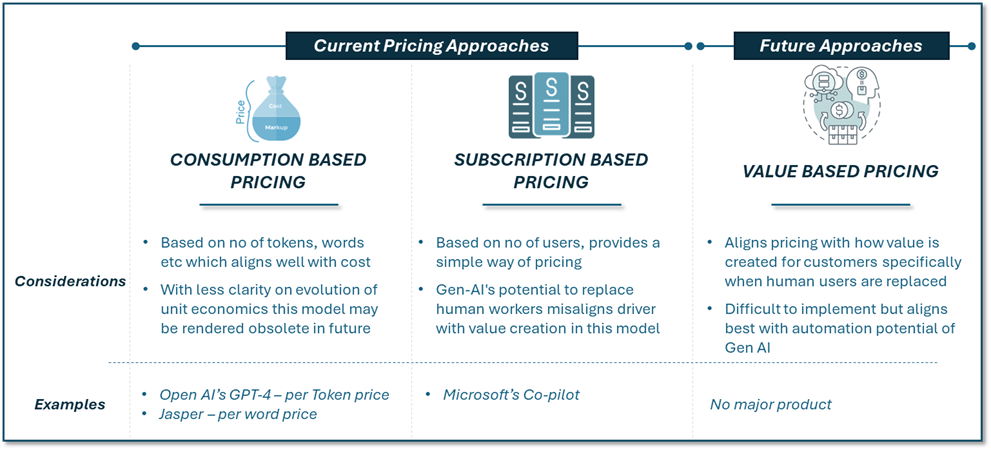What are the key pricing challenges for emerging technologies?
Emerging technologies like AI, blockchain, and IoT are a game changer for a range of industries. Yet, many companies playing in the AI space struggle to price these innovations effectively. They fail to capture the true value, leading to lost revenue and a weaker market position. Businesses need adaptive, value-based pricing models to keep up with fast-paced technological changes and shifting customer expectations.
Shift toward balanced growth:
The era of prioritizing “growth at all costs” or “profit later” for new technologies is fading. Boards are increasingly advocating for balanced growth that emphasize value creation alongside expansion. This shift underscores the importance of aligning business strategies with both short-term performance metrics and long-term strategic goals. For companies bringing emerging technologies to market, such as generative AI, big data analytics, and blockchain, getting their pricing strategy and delivery right in this environment is a key success factor.
Four key challenges in pricing for emerging technologies:
1. Lack of Integrated Pricing Strategy
One of the most common challenges observed with emerging tech players is the absence of a cohesive pricing approach within the overall business strategy and execution. Many companies focus on driving rapid adoption of their novel technologies, often at the expense of initial profitability. This “adoption at all costs” mindset can undermine long-term sustainability and profitability by sending wrong messages about the value of the product and the associated price tag to the market. For instance, in the realm of generative AI, companies might price their solutions based on drivers which may not be scalable as the technology matures, or the driver may be misaligned with the way product generates value for customers
2. Misalignment between Pricing and Product Strategy
Companies often invest heavily in developing robust product roadmap but fail to align it to their pricing strategy. This oversight often results in a critical misalignment between product and pricing, ultimately hampering value creation. Without a cohesive pricing strategy that complements and sometimes even guides the product strategy, companies miss significant revenue opportunities and undermine their ability to innovate. For example, blockchain technology firms might develop advanced secure transaction systems but offer the same product and prices to all their customers without accounting for segment specific needs and value drivers
3. Data Scarcity for Innovative Offerings
Innovative and novel offerings lack comparable market data, making it difficult to establish accurate pricing benchmarks. Without sufficient data, pricing decisions become more speculative, increasing the risk of mispricing products. In such cases, the role of well-executed market research becomes critical. Testing your (potential) customers to discover the value they see in your products and their willingness to pay, and constructing clear use cases with tangible ROI is the optimal approach.
4. Dynamic Customer Willingness to Pay
Customer willingness to pay for emerging tech products is highly variable and evolves as the market matures. Initially, customers may be hesitant to invest in new technologies, but their willingness to pay can increase as they perceive and experience the actual value of these products. Similarly, early adopters may perceive the products as high value and have a higher willingness to pay. This dynamic necessitates a flexible commercial model that can adapt to changing customer segments, perceptions, and market conditions. Natural language processing (NLP) applications, for example, may initially see higher adoption costs which can decrease as recognised use cases increase and customers become more familiar with the technology.
Evolution of pricing strategy for emerging technologies:
As the market for emerging technologies develops, companies would need to shift pricing strategies towards better alignment with customer value. Presently, traditional pricing models such as cost-plus or subscription-based approaches prevail, but they are likely to give way to more dynamic and value-focused pricing frameworks.
A Gen-AI illustration:
Adding value through strategic pricing
Comprehensive Pricing Reviews
A meticulous evaluation of pricing strategy is essential to unlocking vital insights into company’s pricing power and market positioning. We examine three critical components to ensure the robustness of pricing strategies:
-
- Pricing Context: Analysing market dynamics, customer behaviours, and their interplay during the purchasing process.
- Pricing Solution: Assessing product offerings, packaging, pricing guidelines, and implementation.
- Pricing Capabilities: Evaluating the people, processes, and systems involved in pricing.
By scrutinizing the pricing approach through these perspectives, we can identify misalignments between current approach and what is required for optimal performance. For instance, as shown in the example, current pricing models for Generative AI based products rely on either per-token (cost-plus pricing) or per-user (subscription-based) approaches. These methods fail to account for the value delivered to customers, leading to suboptimal financial outcomes both in the short and long term.
Market Research-Driven Commercial Models
Developing a commercial model based on robust market research is crucial. This model should be designed to generate quick value while ensuring long-term success and scalability. By aligning pricing strategies with market realities and business objectives, companies can achieve a more sustainable competitive edge. A good commercial model…
- …aligns value creation with value capture
- …reflects competitive dynamics
- …aligns customer value incentives to company benefits
We examine six critical dimensions to develop a robust commercial model for emerging technologies such as generative AI, big data analytics, natural language processing, and blockchain. Key questions to address include:
- What is the appropriate price positioning for the product?
- How much versioning is needed? For instance, a product based on large language models, like generative AI, can leverage a free version to gather user inputs for training, rapidly enhancing its capabilities.
- How should customers be charged? Should it be based on computational power used, as seen in AI applications, a per-user basis for NLP tools or the number of licenses for big data analytics software?
These are just a few of the questions that must be answered to formulate a holistic pricing strategy. While there is no silver bullet and getting it right can be daunting, the high impact of an effective pricing approach makes this effort well worth the investment.
For further insights on how to choose the best-fit commercial model and what critical components to consider, please refer to our article here.
The benefits of effectively pricing your emerging technology products:
Addressing pricing challenges effectively can yield substantial financial benefits. Research indicates that 80-90% of companies price new products too low, missing out on significant revenue opportunities. In our work with clients, we have seen that by adopting a sound commercial model which aligns with business and product strategies, companies can achieve an EBITDA uplift of 50%-500% over five years. This substantial increase is attainable through disciplined pricing approaches that consider both immediate market conditions and future growth prospects.
In conclusion, navigating the pricing maze in the emerging tech market requires a strategic blend of prudence, flexibility, and data-driven insights. By integrating pricing into the broader business strategy, leveraging market data, and maintaining agility, business leaders can unlock significant value. This balanced approach not only meets boardroom expectations but also ensures sustained commercial excellence in an ever-evolving market
To learn how we can help you establish an optimum pricing approach, reach out to Alex Desyatnik or Pranav Upmannu




